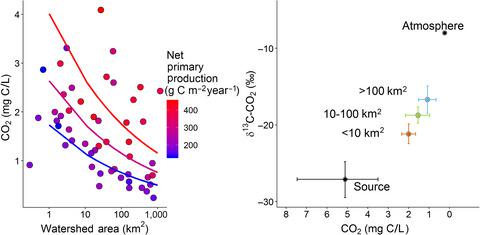当前位置:
X-MOL 学术
›
Glob. Change Biol.
›
论文详情
Our official English website, www.x-mol.net, welcomes your
feedback! (Note: you will need to create a separate account there.)
Fluvial CO2 and CH4 patterns across wildfire-disturbed ecozones of subarctic Canada: Current status and implications for future change.
Global Change Biology ( IF 10.8 ) Pub Date : 2019-12-13 , DOI: 10.1111/gcb.14960 Ryan H S Hutchins 1 , Suzanne E Tank 1 , David Olefeldt 2 , William L Quinton 3 , Christopher Spence 4 , Nicole Dion 5 , Cristian Estop-Aragonés 2 , Samson G Mengistu 1
Global Change Biology ( IF 10.8 ) Pub Date : 2019-12-13 , DOI: 10.1111/gcb.14960 Ryan H S Hutchins 1 , Suzanne E Tank 1 , David Olefeldt 2 , William L Quinton 3 , Christopher Spence 4 , Nicole Dion 5 , Cristian Estop-Aragonés 2 , Samson G Mengistu 1
Affiliation

|
Despite occupying a small fraction of the landscape, fluvial networks are disproportionately large emitters of CO2 and CH4 , with the potential to offset terrestrial carbon sinks. Yet the extent of this offset remains uncertain, because current estimates of fluvial emissions often do not integrate beyond individual river reaches and over the entire fluvial network in complex landscapes. Here we studied broad patterns of concentrations and isotopic signatures of CO2 and CH4 in 50 streams in the western boreal biome of Canada, across an area of 250,000 km2 . Our study watersheds differ starkly in their geology (sedimentary and shield), permafrost extent (sporadic to extensive discontinuous) and land cover (large variability in lake and wetland extents). We also investigated the effect of wildfire, as half of our study streams drained watersheds affected by megafires that occurred 3 years prior. Similar to other boreal regions, we found that stream CO2 concentrations were primarily associated with greater terrestrial productivity and warmer climates, and decreased downstream within the fluvial network. No effects of recent wildfire, bedrock geology or land cover composition were found. The isotopic signatures suggested dominance of biogenic CO2 sources, despite dominant carbonate bedrock in parts of the study region. Fluvial CH4 concentrations had a high variability which could not be explained by any landscape factors. Estimated fluvial CO2 emissions were 0.63 (0.09-6.06, 95% CI) and 0.29 (0.17-0.44, 95% CI) g C m-2 year-1 at the landscape scale using a stream network modelling and a mass balance approach, respectively, a small but potentially important component of the landscape C balance. These fluvial CO2 emissions are lower than in other northern regions, likely due to a drier climate. Overall, our study suggests that fluvial CO2 emissions are unlikely to be sensitive to altered fire regimes, but that warming and permafrost thaw will increase emissions significantly.
中文翻译:

加拿大亚北极地区受野火影响的生态区的河流 CO2 和 CH4 模式:现状和对未来变化的影响。
尽管只占景观的一小部分,但河流网络是不成比例的大量 CO2 和 CH4 排放源,具有抵消陆地碳汇的潜力。然而,这种抵消的程度仍然不确定,因为目前对河流排放的估计通常不会超出单个河流范围和复杂景观中的整个河流网络。在这里,我们研究了加拿大西部寒带生物群落 250,000 平方公里区域的 50 条溪流中 CO2 和 CH4 的广泛浓度模式和同位素特征。我们研究的分水岭在地质(沉积和地盾)、永久冻土范围(零星到广泛不连续)和土地覆盖(湖泊和湿地范围的巨大变化)方面截然不同。我们还调查了野火的影响,因为我们研究的一半流域是受 3 年前发生的特大火灾影响的排水流域。与其他北方地区类似,我们发现溪流中的 CO2 浓度主要与更高的陆地生产力和更温暖的气候有关,并在河流网络的下游减少。没有发现近期野火、基岩地质或土地覆盖成分的影响。同位素特征表明生物成因的 CO2 来源占主导地位,尽管在研究区域的部分地区碳酸盐岩基岩占主导地位。河流 CH4 浓度具有很高的可变性,无法用任何景观因素来解释。使用河流网络建模和质量平衡方法,在景观尺度上,估算的河流 CO2 排放量分别为 0.63(0.09-6.06,95% CI)和 0.29(0.17-0.44,95% CI)g C m-2 year-1 , 景观 C 平衡的一个小但潜在重要的组成部分。这些河流中的二氧化碳排放量低于其他北部地区,这可能是由于气候干燥。总的来说,我们的研究表明,河流中的二氧化碳排放不太可能对变化的火情敏感,但变暖和永久冻土融化会显着增加排放。
更新日期:2020-01-23
中文翻译:

加拿大亚北极地区受野火影响的生态区的河流 CO2 和 CH4 模式:现状和对未来变化的影响。
尽管只占景观的一小部分,但河流网络是不成比例的大量 CO2 和 CH4 排放源,具有抵消陆地碳汇的潜力。然而,这种抵消的程度仍然不确定,因为目前对河流排放的估计通常不会超出单个河流范围和复杂景观中的整个河流网络。在这里,我们研究了加拿大西部寒带生物群落 250,000 平方公里区域的 50 条溪流中 CO2 和 CH4 的广泛浓度模式和同位素特征。我们研究的分水岭在地质(沉积和地盾)、永久冻土范围(零星到广泛不连续)和土地覆盖(湖泊和湿地范围的巨大变化)方面截然不同。我们还调查了野火的影响,因为我们研究的一半流域是受 3 年前发生的特大火灾影响的排水流域。与其他北方地区类似,我们发现溪流中的 CO2 浓度主要与更高的陆地生产力和更温暖的气候有关,并在河流网络的下游减少。没有发现近期野火、基岩地质或土地覆盖成分的影响。同位素特征表明生物成因的 CO2 来源占主导地位,尽管在研究区域的部分地区碳酸盐岩基岩占主导地位。河流 CH4 浓度具有很高的可变性,无法用任何景观因素来解释。使用河流网络建模和质量平衡方法,在景观尺度上,估算的河流 CO2 排放量分别为 0.63(0.09-6.06,95% CI)和 0.29(0.17-0.44,95% CI)g C m-2 year-1 , 景观 C 平衡的一个小但潜在重要的组成部分。这些河流中的二氧化碳排放量低于其他北部地区,这可能是由于气候干燥。总的来说,我们的研究表明,河流中的二氧化碳排放不太可能对变化的火情敏感,但变暖和永久冻土融化会显着增加排放。







































 京公网安备 11010802027423号
京公网安备 11010802027423号